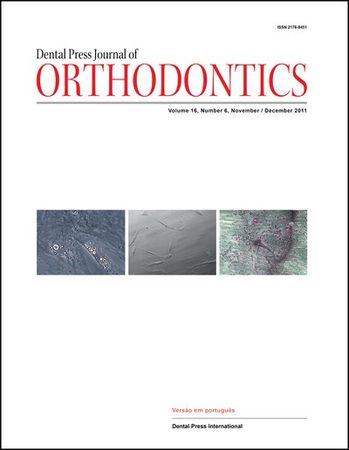Editorial Board
Autores:
messages.RevistaAutores: Corpo Editorial,
LEIA MAIS
Tele-orthodontics: Tool aid to clinical practice and continuing education
Introduction: Information technology is revolutionizing interpersonal relations. This new context has made possible the pursuit of professions in the health area, a concept known as telehealth. The essence of this area is the provision of health information at distance. In this context,...
Autores: Cléber Bidegain Pereira, Alcion Alves Silva, André Luciano Pasinato Da Costa,
messages.RevistaAutores: orthodontics, Telemedicine, Computers, Information technology, Information systems,
LEIA MAIS
Orthodontic movement does not induce external cervical resorption (ECR)
This study sought to explain, both anatomically and functionally, how the cervical region of human teeth is structured and organized in order to address the following questions: 1) Why does External Cervical Resorption (ECR) occur in human dentition? 2) Why is there no ECR in gingivitis and...
Autores: Alberto Consolaro, Renata B. Consolaro,
messages.RevistaAutores: External cervical resorption, Tooth resorption, Orthodontic treatment, Gingiva,
LEIA MAIS
Interview with Lysle E. Johnston Jr.
Lysle E. Johnston Jr. is Professor Emeritus in Dentistry at the University of Michigan and in Orthodontics at Saint Louis University. He graduated in Dentistry from Michigan School of Dentistry in 1961, and in Orthodontics from Michigan’s Horace H. Rackham School of Graduate Studies, 1964. He...
Autores: Cristiana Vieira de Araújo,
messages.RevistaAutores: entrevista,
LEIA MAIS
Analysis of the use of sample size calculation and error of method in researches published in Brazilian and international orthodontic journals
Introduction: Reliable sample size and an appropriate analysis of error are important stepsto validate the data obtained in a scientific study, in addition to the ethical and economicissues. Objective: To evaluate, quantitatively, how often the researchers of orthodonticscience have used the...
Autores: Cátia Cardoso Abdo Quintão, Marco Antonio De Oliveira Almeida, David Normando,
messages.RevistaAutores: Biostatistics, Sample size, Error of methods,
LEIA MAIS
In vitro evaluation of force delivered by elastomeric chains
Objective: To evaluate and compare, in vitro, the decrease in the forces delivered in three groups of elastomeric chains, produced by the same manufacturer, according to the distance between links (short, medium, long). Methods: The segments of elastomeric chains were stretched and kept...
Autores: Lincoln Issamu Nojima, Andréa Fonseca Jardim Da Motta, Adriana De Alcantara Cury Saramago,
messages.RevistaAutores: Orthodontic appliances, Dental materials, Elastomers,
LEIA MAIS
Prospective cephalometric study of the effects of maxillary protraction therapy associated with intermaxillary mechanics
Objective: The early diagnosis and treatment of skeletal Class III (Pattern III) is still a much debated topic in orthodontic literature. Maxillary protraction associated with rapid maxillary expansion is the most popular and widely researched approach, producing the best results in the shortest...
Autores: Guilherme Thiesen, Juliana De Oliveira Da Luz Fontes,
messages.RevistaAutores: Malocclusion, Palatal Expansion Technique, Extraoral traction appliances, Prognathism,
LEIA MAIS
Cephalometric study of tooth position in young Afro-Caucasian Brazilian individuals with normal occlusion
Objective: The purpose of this study was to achieve a specific cephalometric pattern for young Afro-Caucasian Brazilian individuals and verify the presence of dimorphism between sexes. Methods: The sample was composed of 40 lateral cephalograms of young Afro-Caucasian Brazilian individuals...
Autores: Arnaldo Pinzan, Guilherme Janson, Eduardo Jacomino Franco, Célia Regina Maio Pinzan-Vercelino, José Fernando Castanha Henriques,
messages.RevistaAutores: Ethnic groups, Cephalometrics, Incisors,
LEIA MAIS
Cephalometric evaluation of the effects of a mandibular protraction appliance (MPA) combined with fixed orthodontic appliance on dentoalveolar and soft tissue structures of Class II, division 1 patients
Objective: To perform a cephalometric evaluation of dentoalveolar and soft tissue changes in Brazilian youths with Class II, division 1 malocclusion, treated with a mandibular protraction appliance (MPA) combined with fixed corrective orthodontics. Methods: The sample consisted of 28 patients (16...
Autores: Raniere Luiz Dos Santos Sousa, Alexandre Magno De Negreiros Diógenes, Rildo Medeiros Matoso, Emmanuelle Medeiros De Araújo, Kenio Costa Lima,
messages.RevistaAutores: Cephalometry, Mandibular protraction appliance, Class II, Division 1 malocclusion, Dentoalveolar and soft tissue changes,
LEIA MAIS
Shear bond strength of Concise and Transbond XT composites with and without bonding agent
Objectives: The aim of this study was to evaluate the shear bond strength of brackets and the adhesive remnant index (ARI) of Concise and Transbond XT composites with and without the use of a bonding agent. Methods: The sample consisted of 60 bovine incisors divided into four groups (n=15). All...
Autores: Fábio Lourenço Romano, Américo Bortolazzo Correr, Alexandre Maêda Neves,
messages.RevistaAutores: orthodontics, Shear strength, Dental bonding,
LEIA MAIS
Bolton analysis: An alternative proposal for simplification of its use
Autores: Ary Dos Santos-Pinto, João Roberto Gonçalves, Karina Eiras Dela Coleta Pizzol, Adriano Porto Peixoto,
messages.RevistaAutores: Diagnosis, Bolton’s analysis, Tooth size discrepancy, Orthodontic treatment planning,
LEIA MAIS
Changes in pogonion and nose according to breathing patterns
Introduction: The soft tissue profile results from complex changes in the hard and soft tissues of the face. The pogonion and the nose are dominant facial structures that determine the degree of profile convexity and should, therefore, be analyzed and included in orthodontic treatment planning....
Autores: Orlando Tanaka, Luciana Borges Retamoso, Suelem Tisiane Fabianski, Lílian Mary Karakida, Luégya Amorin Henriques Knop,
messages.RevistaAutores: Mouth breathing, Nose, Pogonion, Nose breathing,
LEIA MAIS
Mouth breathing within a multidisciplinary approach: Perception of orthodontists in the city of Recife, Brazil
Objectives: To assess the knowledge of a mouth breathing pattern among orthodontists in the city of Recife, Brazil, and to examine their treatment protocols. Methods: In this cross-sectional study, members of the Orthodontics and Facial Orthopedics Association of Pernambuco responded individual...
Autores: Valdenice Aparecida De Menezes, Luiza Laranjeira Cavalcanti, Tâmara Cavalcanti De Albuquerque, Ana Flávia Granville Garcia, Rossana Barbosa Leal,
messages.RevistaAutores: orthodontics, Perception, Mouth breathing,
LEIA MAIS
Assessment of force decay in orthodontic elastomeric chains: An in vitro study
Introduction: Elastomeric materials are considered important sources of orthodontic forces. Objective: To assess force degradation over time of four commercially available orthodontic elastomeric chains (Morelli, Ormco, TP and Unitek). Methods: The synthetic elastics were submerged in 37 ºC...
Autores: Ernani Menezes Marchioro, Luciane Hahn, Claudia Kochenborger, Dayanne Lopes Da Silva, Diogo Antunes Vargas,
messages.RevistaAutores: Elastics, Synthetic elastics, Elastomeric chain,
LEIA MAIS
Orthodontic-surgical treatment of skeletal facial asymmetry: Case report
Introduction: Facial asymmetries consist of an imbalance between the homologous skeletal structures of the face. Most people present some degree of facial asymmetry, since a state of perfect symmetry is rare. This common asymmetry only becomes relevant when it is perceivable by the patient. In...
Autores: Susiane Allgayer, Waldemar Daudt Polido, Carlos Alberto Estevanell Tavares, Gabriella Rosenbach, Fernanda Santos Mezzomo,
messages.RevistaAutores: Corrective Orthodontics, Esthetics, Facial asymmetry, Tooth extraction,
LEIA MAIS
Collection and culture of stem cells derived from dental pulp of deciduous teeth: Technique and clinical case report
Introduction: Stem cells (SCs) are capable of inducing tissue regeneration and are, therefore, potentially therapeutic. Similarly to bone marrow and umbilical cords, dental pulp is one of the available sources of SCs. The fact that these cells are easily accessible and that deciduous teeth are...
Autores: Telma Martins De Araújo, Ana Prates Soares, Alan Araujo De Jesus, Milena Botelho Pereira Soares, Renata Campos Nogueira, Elisalva Teixeira Guimarães, Ricardo Ribeiro Dos Santos,
messages.RevistaAutores: Stem cells, Deciduous teeth, Cell culture techniques, Tissue therapy,
LEIA MAIS
Angle Class I malocclusion with bimaxillary dental protrusion and missing mandibular first molars
This case report describes the orthodontic treatment of a 24-year-old patient presenting with Angle Class I malocclusion, bimaxillary dental protrusion and recent loss of mandibular molars. Treatment involved extraction of the maxillary first premolars and closing of mandibular first molar...
Autores: Aldino Puppin Filho,
messages.RevistaAutores: Corrective Orthodontics, Angle Class I malocclusion, Orthodontic space closure, Biomechanics,
LEIA MAIS
Molar extractions in orthodontics
Orthodontic treatment with extraction of molars in adult patients is technically more complex due to a number of factors. In general, the space to be closed is greater than premolar spaces rendering critical anchorage and longer treatment time. Often such cases exhibit some degree of periodontal...
Autores: Daniela Kimaid Schroeder, Marco Antonio Schroeder, Diego Júnior Silva Santos, Michelle Machado Leser,
messages.RevistaAutores: Corrective Orthodontics, Angle Class I malocclusion, Tooth extraction,
LEIA MAIS



